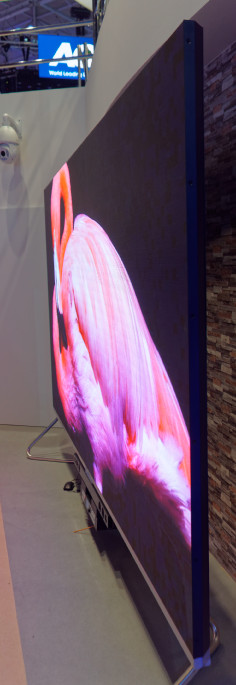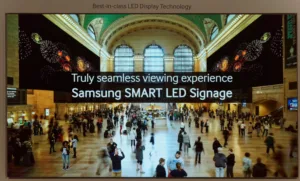I’ve just got to the end of editing our report on the ISE show – a great event now for large displays and audio visual. After last year’s event, the key message was that small pixel pitch LED had started to get very interesting. This year, the whole circus has moved on.

 Unilumin 138 inch LED TV –
Unilumin 138 inch LED TV –
image – Bob RaikesLet’s be clear before I start. I’m not talking about LED-backlit TVs, I’m talking about displays where each sub-pixel is actually an individual LED. The market has seen massive development over the last few years and was generating a lot of interest among those that previously have not paid any attention to LED.
Originally, when LEDs were first used, the devices were very big and had very poor colour performance – especially the blue. Each colour (RGB) needed an individually packaged LED and so the pixel pitch had to be quite wide (10mm to 20mm) and companies developed all sorts of “sub-pixel addressing” schemes to boost apparent resolution. Over time, the packaging and light extraction got better and better and the colour quality improved. LED makers made the chips smaller and smaller and eventually, they were able to put all three coloured LEDs into a single package.
We looked at this market for an investment project around 10 years ago and at that time, the “State of the Art” was a pixel pitch of 3mm, which was available from Barco, although the cost was huge (>€100,000 per sq. m at the time). Gradually, over the years, the smallest pitch has come down and down. At ISE 2012, Lang showed a 1.9mm pitch display from Silicon Core and pricing was quoted at €37,000 per m² – a relative bargain!
By last year, Aoto of China was claiming a 1mm pitch display, but when we got there, the display was not powered up “to show how good the black is”. This year, there were lots of sub-2mm LEDs and Samsung, a new entrant in the field as we reported from CES, (No More Plasma for Samsung, But LED is New Category – subscription required) was showing a very good looking 1.1mm display. The calculation of a FullHD resolution display would mean a pitch of 0.75mm for A 130″ TV.
We interviewed Silicon Core about its 1.2mm pitch display at Gitex (the firm has some nice technology to minimise moiré in TV applications).
Developments in LED TVs
The first “LED TV” that I remember writing about was from Philips’ Vidiwall, which showed a less than standard definition (384 x 216) resolution 6mm 120″ TV for only €170,000 at the Satis show in Paris in 2005. Things have moved on since then, and last year we spoke to ANFLED of China, at IFA and Gitex in Dubai. ANFLED makes 218″ FullHD LED TVs for the bargain price of $315,000. The company told us that it was getting a better sales response at Gitex than in Germany.
By ISE 2015, there were lots of good looking LED displays from new entrants, the Chinese makers and “Traditional” LED suppliers such as Barco, Hibino and Daktronics also had good looking displays. We found three “LED TVs” at ISE (although I would bet we missed some! Let me know if you saw another!)
- Unilumin had a 138″ FullHD “TV” with a price of $115,000 and 1.58mm pitch
- Leyard had a 108″ LED display for use as a TV, although pricing is “to be confirmed” and that has a 1.2mm pitch
- Aoto had what it claimed was a 0.75mm pitch 65″ “TV” although it was mounted high up, so it was hard to confirm
LEDs are notoriously variable in quality and performance, as they come off the production line. That means that if you want to have a really good quality display over a long time, the LEDs have to be carefully selected or “binned” to match efficiency and colour performance and then the performance has to be monitored over time. That costs a lot and means that, unlike most display technologies, it’s not the area that really drives the cost, but the number of pixels. We’re used to the idea that display prices should reflect the diagonal (or area), so there’s a bit of a disconnect when the cost per sq. m. goes up as the display size goes down for a fixed resolution.
Price, Price, Price
Now, back at CES in 2012, Sony showed a “CrystalLED” 55″ FullHD TV that was said to be made from inorganic LEDs. At the time, I did a quick calculation that Sony would have to be able to buy .01 cents each – that is 10,000 LEDs for a dollar – to stand any chance of competing with LCD TVs. Since then, TV has gone to UltraHD, so prices would have to be a quarter of that (and LCDs have got cheaper!) so they would probably have to buy 50,000 for a dollar.
Now, I’m no expert on LED manufacturing costs, but at the time, another company was telling us that it could make “low cost” LEDs on silicon wafers. The firm boasted that it could make 17,000 LEDs on a single wafer. At the time, a wafer cost $500, which would mean 34 for a dollar, so you can see the gap in cost performance can be measured in orders of magnitude.
So, while LED displays are now really attractive, bright and durable, it will be some time, if ever, before they are cheap enough to enter the mainstream of the TV world.
Bob
Here’s an image taken from the Samsung LED:
Samsung got a lot of attention for this 1.1mm LED display at ISE 2015

